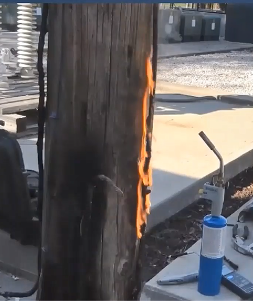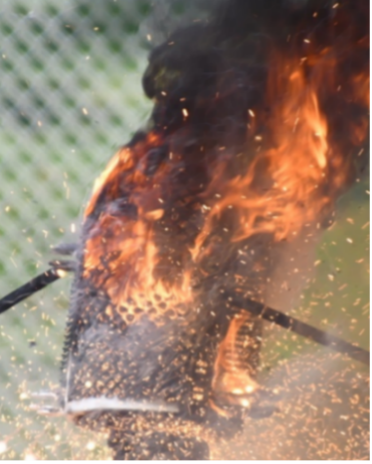Fire Friendly Asset Coatings and Coverings
Many utilities have experienced significant reduction in fault counts by hardening their overhead distribution lines. Such hardening can include stronger poles, covered conductors, covered connectors, and specialized coverings and tapes for other exposed electrified hardware. While line coverings are a mature area of research in the underground space, there are a number of challenges remaining with making coverings and insulators for overhead systems that have long field lifecycles, are animal, weather and moisture hardened and are flame and smoke friendly. The Wildfire Advisory Group prioritized two ignition-mitigation and fire-hardening areas:
- Coverings that reduce ignition opportunities, such as asset covers, connectors, and the coverings used on the wires
- Flame-inhibiting applications, such as intumescent pole wraps, sprays, and applicants that reduce soot and particle deposition on electrified assets.
Coverings that Reduce Ignition Opportunities
When energized equipment fails, the failure mode may ignite portions of the equipment, such as synthetic components, insulating materials and animal guards. While most equipment has protective fuses to quickly isolate the equipment, the fault energy may still be great enough to provide an ignition source to ground vegetation – depending on the fire risk conditions that day.



As a peripheral concern, EPRI testing on different brands of animal guards, insulating tape, conductor coverings, and other types of insulating materials reveal some insightful gaps that warrant new R&D:
- First, the materials that the guards, and other insulating electrical coverings are made from is not being consistently specified and designed to be either flame friendly, or moisture ingress proof.
- Secondly, the same insulative mixtures used for tapes, wraps, and other electric asset coverings have unique combustion concerns whereby the materials can either easily burn or can exacerbate the situation by dripping flaming liquid materials onto the vegetation beneath the coverings.
This issue is not chronic across every insulating material. However, testing legacy products from the field and from newly manufactured inventory could be useful to understand how each mixture performs under a flame test. In the interim a useful generic specification would be when ignited by external flame source, does not self-sustain the flame under any ambient thermal conditions up to 100 degrees C.
Fire Protective Applications
One approach to reducing wildfire risk is to integrate fire-protective materials into overhead distribution infrastructure. Application of fire-protective materials would be expected to reduce wildfire risk by
- Mitigating ignition risk during exposure of overhead distribution components to ignition sources, such as an arc caused by vegetation or wildlife contact, and by
- Improving the fire resistance of overhead components exposed to a wildfire, thereby reducing the need for infrastructure replacement after wildfire exposure.
Fire-protective materials include a wide range of mixtures that inherently withstand high temperatures, react when exposed to high temperatures to create a protective barrier, react to locally inhibit the oxidation process by consuming energy, release moisture or an oxygen-depleting reactive compound, or a combination of any of these. Materials such as concrete and brick are inherently flame resistant. However, many commonly used materials in overhead distribution systems are not inherently flame resistant, such as wood poles, pole top insulators, wildlife guards, and others. Fire protection coatings and wraps have been developed to prevent wood pole combustion in the event of wildfire.
Despite the commercial availability of products that have demonstrated adequate wildfire protection, there are many questions left to be answered. Uncertainties remain regarding long-term performance, long-term resistance to weather, environmental impacts, and end-of-life considerations, how application of protective materials interfere with inspection activities, how protective materials affect the degradation rate of the material to which it is applied (e.g., wood poles), and if repeat application or renewal is needed following exposure to a single wildfire event.
What is needed to accelerate the industry toward the 2030 Vision?
It would be beneficial to work with the U.S. National Labs to develop a selection of insulating mixtures that are flame friendly, UV resistant, and weather impervious and provide the criteria to vendors for future products. EPRI could support with consistent and replicable test criteria to evaluate the performance of the prototype mixtures, and any commercial products developed.
In the fire protective applications space there is a need for a more versatile selection of sprays, coatings and sacrificial wraps for transmission and distribution assets and again, it would be beneficial to work with the National Labs to develop a selection of suitable products based on some WAG defined and SME defined specifications.
Which 2030 Future States are Impacted by this Work?
- Coatings for insulators and electrical hardware that do not retain contaminants
- Fire, and weather friendly, coverings for electrical assets